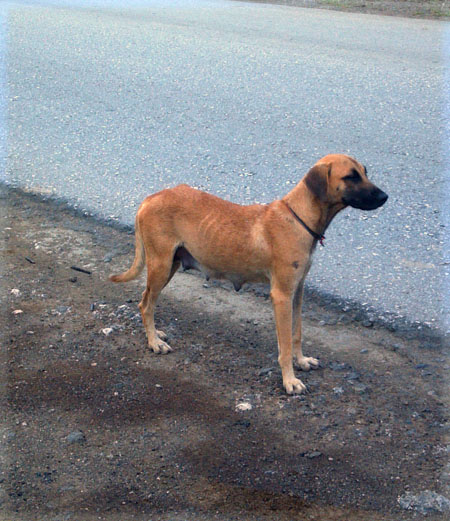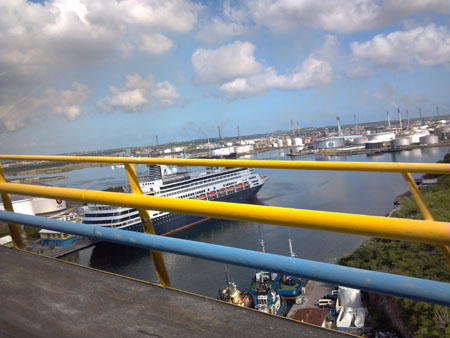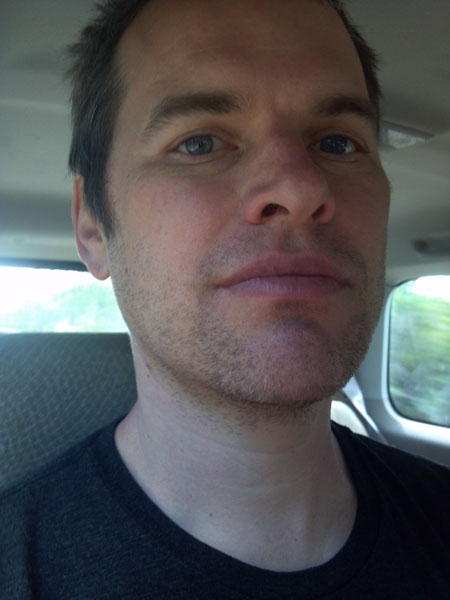|
|
|
Jewish Christmas in the Caribbean
Wednesday, December 25 2013
location: Room 208, Royal Sea Aquarium Resort, Curaçao
This morning, Gretchen and I went with her parents to a beach called Porto Mari far to the west of Willemstad, leaving the Pittsburgh family back at the resort. Curaçao has more diversity of terrain than I expected, with flat-topped mesa-like landforms around sprawling lagoons that reach far inland. One such lagoon is called Jan Kok and, despite apparent attempts to dike and drain it in the usual Dutch fashion, features a population of resident wild flamingos. (Gretchen and I had seen a few flamingos flying the other day and noted how silly they look: black line segment propelled by tiny pink wings.) We stopped to look at the flamingos, which we could see off in the distance from an observation platform. While briefly parked at Jan Kok, one of Curaçao's many semi-wild dogs strolled up. She was a tawny brown with floppy ears and her teats were massive. A string tied around her neck signified a connection to some human somewhere, though the connection might have been tenuous or even expired. I'm used to dogs being silly, rambunctious, security-obsessed, irrationally optimistic, or some combination of all four. But this dog was strictly business. She evidently was there in hopes that we had a spare ham sandwich, and when it was clear that we didn't she moved on.
The less-developed countryside of Curaçao consists of a scrubland of thorny Acacia-like trees and treacherous-looking cacti. One wouldn't want to try to make it through such countryside without good boots and a sharp machete. Somewhere in this landscape, I saw my first Caracara.
At least on Christmas day, it costs nothing to park at Porto Mari. But once on the beach, a woman came by to collect money for our use of the chaise lounges we occupied. Gretchen and I immediately began snorkeling southward along low natural stone cliffs that had all been undercut several feet by wave action. There was lots to see underwater, including numerous trumpetfish, stiff trunkfish (some with black lipstick and eyeliner and others without) and species of small dark-blue fish covered with luminescent blue-green dots that look as if they contain LEDs. Something stung me on my unshaved chin, and I immediately looked around to see who might be the perpetrator and saw a jellyfish about the size of a shotglass. It was snotty white with a two dark patches ("eyespots"). This was just the first of several jellyfish encounters I would have on this swim, and several times as I maneuvered to avoid them I felt like a protagonist in the Matrix trying to avoid a bullet. Gretchen and I swam rather far out along those cliffs, which meant we had a long swim back. Being a weak swimmer, I found the return a bit of a chore. All the saltwater slowly finding its way into my mask and then up my nose made me feel as if I was coming down with a head cold.
By the time I made it back to the beach, I'd stumbled on a rock and cut the top of my foot just outside my reefwalkers and it was still bleeding a little. It was the kind of injury that freaks out a mother-in-law a lot more than it freaks me out.
For lunch, we went to a nearby cantina and ordered fries and beverages to go with the sandwiches we'd packed. Once again I encountered the strangeness of beer sizes in Curaçao; the local beers were only available in 7 ounce or 34 ounce sizes, so to get a 12 ouncer I had to settle for Dos Equis. (Obviously there are no IPAs, or even ales, anywhere in Curaçao, though it's doubtful they would be refreshing in a climate like this. Also, IPAs aren't good with fries and catsup.)
After reading for awhile about Pope Francis from a recent issue of The New Yorker, I went for another round of snorkeling, this time straight out from the beach into increasingly-deep water. By this point I was confident enough in my snorkel to risk being far from any place to stand and readjust. Somewhere out there on the bottom of the deepening shallows are a series of artificial concrete spheres containing circular cutouts. These were the artificial reefs designed to improve the local reef habitat. They seemed to be doing the job; they were full of fish and encrusted with nascent colonies of reefmakers.
Back at our resort, Gretchen had a vision of Jewish Christmas that included the two most essential features: Chinese food and a movie. Yesterday we'd learned that Curaçao has over 300 Chinese restaurants owing to a rule that only allows Chinese people to immigrate if they agree to open a restaurant. The inevitable consequence is that the food tends to be terrible. (People who are trained auto mechanics should not be expected to operate a restaurant.) For this reason, Gretchen made the Chinese food herself, drawing on a variety of vegetables, tofu, tempeh, and making at least two different kinds of rice (one being plain, since that's the only kind of rice one could expect the kids to eat). As for the movie, Gretchen's parents had selected a Bollywood classic from 1999 called Hum Dil De Chuke Sanam. They'd seen it already and considered it appropriate for the children. Indeed, they expected it to be a valuable cultural milestone. In describing what Bollywood movies are, they explained that they contain lots of elaborate musical numbers and gorgeous actors. I've only seen Bollywood movies incidentally, either back in Los Angeles on the analog cable I'd pirated for my condo or in Pakistani and Indian restaurants. Hum Dil De Chuke Sanam would be the first Bollywood movie I would actively watch. Though the language was largely Hindi (English mostly being used to represent foreignness), there were subtitles. Sadie has only learned to read relatively recently, and she had difficulty keeping up with the reading required to follow along, so Gretchen narrated parts of it for her. The plot of Hum Dil De Chuke Sanam centered around Pandit Darbar, a classical music teacher, a student supposedly from Italy named Sameer(?!?!), and the forbidden love Sameer develops for Pandit's ravishingly gorgeous daughter Nandini. Eventually Nandini is betrothed to another man for whom she has no love and Pandit orders Sameer to never again have contact with his daughter. At that point, after an hour and a half of drama, the movie claimed it was time for "intermission," and since it was late, we decided to watch the second half tomorrow.

Across from a bar/restaurant called Williwood on the edge of the Jan Kok lagoon. (Click to enlarge.)

The mama dog at the flamingo stop along the Jan Kok lagoon.

A cruise ship in the Willemstad harbor with the oil refineries in the background. (Click to enlarge.)

Me in Curaçao today.
For linking purposes this article's URL is:
http://asecular.com/blog.php?131225 feedback
previous | next |



